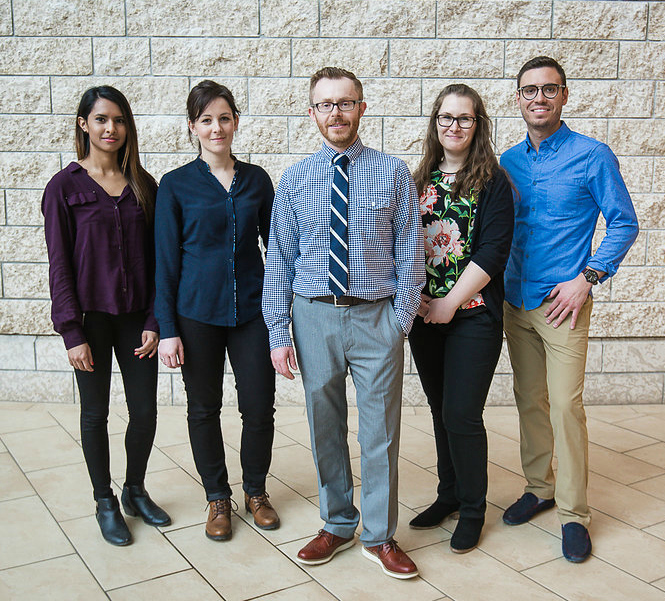
Important research on our smallest blood cells. The platelet research team: (L-R) Natasha Govindasamy, Gabriela Lesyk, Dr. Paul Jurasz, Valentina Back and Dr. Jan Rudzinski (surgical resident).
To view the research professor Paul Jurasz and his team are doing on platelets, the smallest of our blood cells, you would need a microscope.
The tiny cells, whose primary function is to stop your body from bleeding when you get a cut, are only visible using specialized lab equipment.
But for Jurasz, the significance of those tiny cells is large because of the important role they also play in causing heart attacks and strokes, and clotting in treating cancer patients.
For the past five years, Jurasz and his team in the Pharmaceutical Sciences division of the faculty have been conducting research to better understand the role platelets play in hemostasis, the process which causes bleeding to stop in the body. Specifically, they're looking at different types of platelets and how they promote and inhibit the blood clotting process in the body.
The team has three concurrent projects all focused on platelets and the potential for developing new drugs to target these cells once thought of as 'Band-Aids of the vascular system.' The projects are funded through Canadian Institutes of Health Research (CIHR), Alberta Diabetes Institute and Johnson & Johnson, and Heart and Stroke Foundation of Canada grants.
"Our first project is still in the early stages of research," says Jurasz. "We're trying to understand the basic biology of platelets, specifically in two areas: their role in hemostasis, the regulation of the vascular system to stop bleeding and their role in thrombosis, which is the inappropriate formation of blood clots."
For years, most researchers who studied platelets believed they were mostly the same or homogeneous. Jurasz and his team think otherwise - that there are unique characteristics in all platelets.
So far, his team's research has identified that there are two types: platelets that can produce a molecule called nitric oxide and ones that don't. "The reason nitric oxide is important is because platelets with this molecule in it can temper a blood clot and make sure it only clots blood in the place where you need it to clot," he says. "So, it regulates the blood clotting process because if it didn't, you would have blood clots throughout your body."
Jurasz says once his team understands the system and how it works, they can target these cells with novel drug therapy to better regulate the clotting abilities. His team has plenty of help - no less than 14 authors helped write a research paper he just submitted for review. His Pharmacy and Pharmaceutical Sciences team includes four graduate students and he collaborates with several other researchers in the Faculty of Pharmacy and Pharmaceutical Sciences and Faculty of Medicine and Dentistry - all focused on the same goal.
"Our end goal would be to use this research to develop drugs that would prevent heart attacks and strokes, specifically ischemic strokes which are caused by clots," he says.
His team is also studying how platelets contribute to blood vessel growth. Modern research on the topic suggest that platelets no longer just serve as a Band-Aid for the vascular system, like previous researchers believed. He says a more modern, updated view is that platelets play a role in many different physiological processes and diseases as well.
"Platelets have granules in them and these granules are the largest circulating store of factors that can either promote or inhibit new blood vessel growth," says Jurasz.
Early in his research career, Jurasz identified in platelets a very potent factor that inhibits blood vessel growth.
"If we can block this inhibitor, then we may be able to promote the growth of new vessels to get around blocked arteries and to treat coronary artery and peripheral artery disease in this manner," he says. "I think that one of the reasons that clinical trials have had only modest success in this area is that none of the trials were looking at this inhibitor - instead they were looking at promoting factors that promote growth."
Jurasz uses the analogy of trying to move a car forward. If the driver steps on the gas pedal and the brake pedal at the same time, the car doesn't move forward. If you take your foot off the brake, the car moves forward.
"We're looking at blocking or interrupting the inhibitor so the platelets would only promote new blood vessel growth," he says. 'We're looking to the future and trying to develop a drug that could target the blood vessel inhibiting characteristic of the platelet."
Another area where the team's research is looking to make an impact is in cancer treatment.
Jurasz notes that cancer patients have an activated hemostatic system, which means they get a lot of blood clots. As far back as the mid 1800s, Jurasz says pathologists knew that blood platelets contributed to this clotting.
"The pathologists proposed that these platelets could be helping cancer cells be spread from one part of the body to another," he says. "Cancer cells travel using one of two pathways through the body - through the bloodstream or the lymphatic system. Our research is focused on understanding that platelet / cancer cell interaction during spread through the bloodstream."
Jurasz says it's important to understand this interaction because once they understand how a platelet contributes to cancer cells metastasizing, they can attempt to develop drug therapies to inhibit or stop that spread altogether improving the cancer patient's chance of survival.
When it comes to one of the smallest cells in our body, the Faculty of Pharmacy and Pharmaceutical Sciences has big plans to help understand the biology of these cells and how that research can contribute to healthier outcomes for patients.